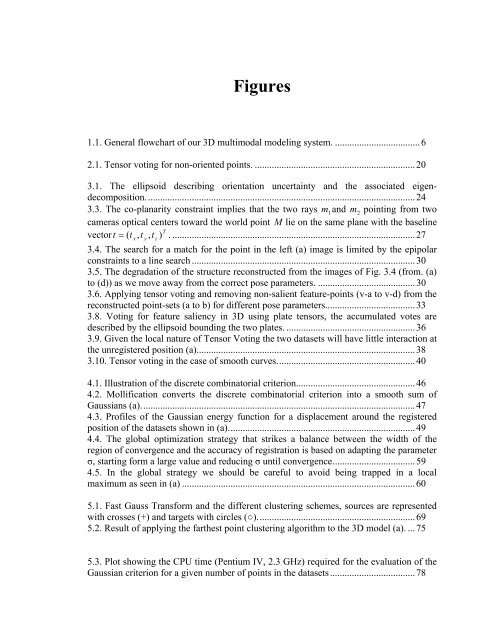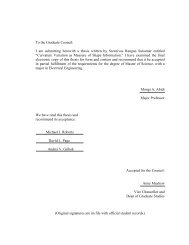To the Graduate Council: I am submitting herewith a dissertation ...
To the Graduate Council: I am submitting herewith a dissertation ...
To the Graduate Council: I am submitting herewith a dissertation ...
- No tags were found...
You also want an ePaper? Increase the reach of your titles
YUMPU automatically turns print PDFs into web optimized ePapers that Google loves.
Figures1.1. General flowchart of our 3D multimodal modeling system. ...................................62.1. Tensor voting for non-oriented points. ..................................................................203.1. The ellipsoid describing orientation uncertainty and <strong>the</strong> associated eigendecomposition...............................................................................................................243.3. The co-planarity constraint implies that <strong>the</strong> two rays m 1and m2pointing from twoc<strong>am</strong>eras optical centers toward <strong>the</strong> world point M lie on <strong>the</strong> s<strong>am</strong>e plane with <strong>the</strong> baselineTvectort = ( tx, ty, tz) . ....................................................................................................273.4. The search for a match for <strong>the</strong> point in <strong>the</strong> left (a) image is limited by <strong>the</strong> epipolarconstraints to a line search ............................................................................................303.5. The degradation of <strong>the</strong> structure reconstructed from <strong>the</strong> images of Fig. 3.4 (from. (a)to (d)) as we move away from <strong>the</strong> correct pose par<strong>am</strong>eters. ........................................303.6. Applying tensor voting and removing non-salient feature-points (v-a to v-d) from <strong>the</strong>reconstructed point-sets (a to b) for different pose par<strong>am</strong>eters.....................................333.8. Voting for feature saliency in 3D using plate tensors, <strong>the</strong> accumulated votes aredescribed by <strong>the</strong> ellipsoid bounding <strong>the</strong> two plates. .....................................................363.9. Given <strong>the</strong> local nature of Tensor Voting <strong>the</strong> two datasets will have little interaction at<strong>the</strong> unregistered position (a)..........................................................................................383.10. Tensor voting in <strong>the</strong> case of smooth curves.........................................................404.1. Illustration of <strong>the</strong> discrete combinatorial criterion.................................................464.2. Mollification converts <strong>the</strong> discrete combinatorial criterion into a smooth sum ofGaussians (a).................................................................................................................474.3. Profiles of <strong>the</strong> Gaussian energy function for a displacement around <strong>the</strong> registeredposition of <strong>the</strong> datasets shown in (a).............................................................................494.4. The global optimization strategy that strikes a balance between <strong>the</strong> width of <strong>the</strong>region of convergence and <strong>the</strong> accuracy of registration is based on adapting <strong>the</strong> par<strong>am</strong>eterσ, starting form a large value and reducing σ until convergence..................................594.5. In <strong>the</strong> global strategy we should be careful to avoid being trapped in a localmaximum as seen in (a) ................................................................................................605.1. Fast Gauss Transform and <strong>the</strong> different clustering schemes, sources are representedwith crosses (+) and targets with circles (○).................................................................695.2. Result of applying <strong>the</strong> far<strong>the</strong>st point clustering algorithm to <strong>the</strong> 3D model (a). ...755.3. Plot showing <strong>the</strong> CPU time (Pentium IV, 2.3 GHz) required for <strong>the</strong> evaluation of <strong>the</strong>Gaussian criterion for a given number of points in <strong>the</strong> datasets...................................78
















